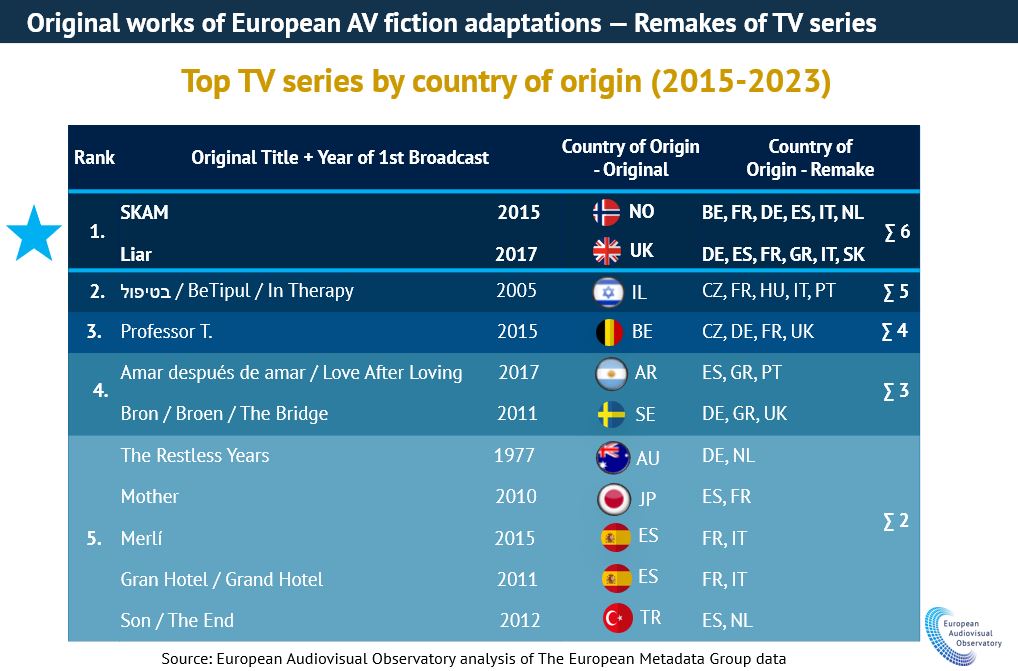Research: 88% European TV/SVoD fiction adaptations based on European works
May 27, 2025

A report, Adaptations in audiovisual fiction production in Europe – 2023 figures, from the European Audiovisual Observatory, analyses adaptations in European audiovisual fiction production between 2015 and 2023. Its aim was to provide figures and context on the production of audiovisual content in Europe.
The report found that 88 per cent of European TV and SVoD fiction adaptations are based on original works from Europe. More than half of them come from the UK (23 per cent), Germany (17 per cent), France (10 per cent), and Spain (7 per cent). Around one in ten (12 per cent) of all European audiovisual fiction adaptations are based on non-European works, 6 per cent of which originate from the US.
Adaptations have become a staple of European audiovisual fiction production. 14 per cent of all audiovisual fiction works produced in Europe between 2015 and 2023 were adaptations – the equivalent of 1,524 TV film and TV series adaptations. On average, over 160 titles and more than 1,400 hours of audiovisual fiction adaptations are produced each year in Europe.

Streamers offer more adaptations
Compared to broadcasters, streamers rely more on adaptations. Between 2021 and 2023, their share of adaptations with regards to their total original fiction production was higher (20 per cent) than that of private (15 per cent) and public broadcasters (11 per cent).
Public service broadcasters in major markets and Netflix are the top commissioners of audiovisual fiction adaptations. The BBC, ZDF, Netflix, ARD and France Télévisions have each commissioned more than 100 adaptations between 2015 and 2023.

Most fiction adaptations are based on books and TV series
Most audiovisual fiction adaptations are based on books (74 per cent) and TV series (19 per cent). Crime and detective novels are the most frequently adapted books. British icon Agatha Christie and Austrian author Claudia Rossbacher lead the way with ten adaptations each between 2015 and 2023.
The number of book adaptations decreased by 13 per cent from 2022 to 2023. This decrease is mainly driven by the overall decrease in European audiovisual fiction production of minus 6 per cent.
The majority of audiovisual fiction adaptations based on books are works first published after the year 2000 (68 per cent). Adapted books first published in the 20th century accounted for 28 per cent and pre-20th-century books represented 4 per cent.
Books used for audiovisual fiction adaptations are mainly national while TV series are mainly international. For books, the country of origin is the same as the country of production in four out of five cases (82 per cent). For TV series, the country of origin is different from the country of production in nine out of ten cases (92 per cent).
The Norwegian TV series SKAM and the British TV series Liar (pictured) have the highest number of remakes in six European countries each. Other popular adapted TV series include Israeli בטיפול / BeTipul (In Therapy) with five European remakes and Belgian Professor T. with remakes in four European countries.

The UK has the highest share of adaptations with regards to UK produced works of audiovisual fiction (25 per cent), followed by Italy (19 per cent), Sweden and France (18 per cent each), Spain (17 per cent) and Poland (15 per cent).
The emphasis on the type of original works varies between the top ten producing countries for AV fiction adaptations. British and German audiovisual fiction adaptations favour books as their principal source. Dutch and Czech audiovisual fiction adaptations are based equally on books and TV series.
Most audiovisual fiction adaptations are either high-end TV series with 13-episodes-or-less-per-season (54 per cent) or TV films (36 per cent).
The share of adaptations in audiovisual fiction co-productions is significantly higher (23 per cent) than in non co-productions (13 per cent).
